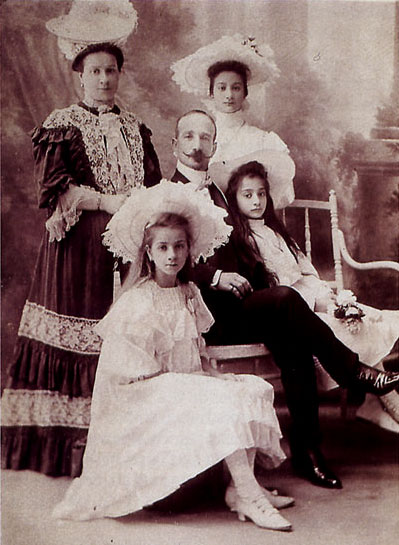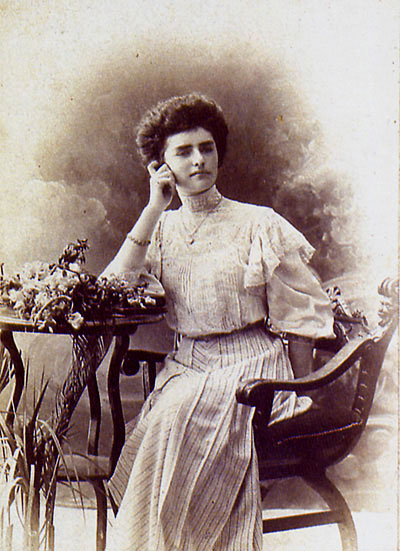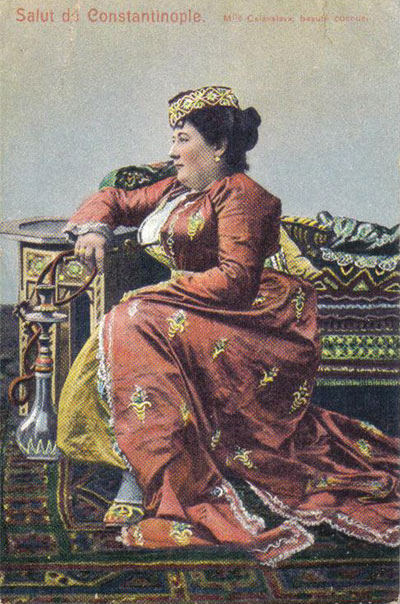 |
These
charming portraits of individuals and families are photos taken around the
turn of the century, judging by the clothes. The family portrait postcard
is marked by the firm Sébah
& Joaillier of 439 Grand Rue de Pera of Constantinople while
the lady below was photographed at Atelier Apetton in the same city.
 |
 |
 |
From a book-leaf from Portrait Types of the Midway Plaisance; published in 1894 by N. D. Thompson, St. Louis, USA. This book collected portraits of personalities at the 1893 World’s Columbian Exposition in Chicago. For the Exposition, the mile-long Midway Plaisance was turned over to the theatrical entrepreneur Sol Bloom, a protégé of Chicago mayor Carter Harrison. It became a grand mix of fakes, hokum, and the genuinely educational and introduced the “hootchy-cootchy” version of the belly dance in the “Street in Cairo” amusement; it was the most popular, with 2.25 million admissions.
The printed captions are frequently condescendingly ethnocentric and occasionally blatantly racist.
This page is titled: ‘Mr. George Pangalo: Native of Smyrna, Turkey (1893)
It would be difficult to say of just what race this gentelman is a type. He was born in Smyrna, of an English mother and a Greek father, and his paternal grandmother was Italian. Perhaps he is entitled to a place in a work on race types as a forerunner of that final race who are to possess the earth when all the nations of globe shall be of one blood. When a child, he was taken to Constantinople, where he was educated in Roberts’ College, an American institution, conducted by the Congregationalists. On graduating he entered railroad service for five years; then he spent one year as a bank clerk in Salonica; and then he gave one year to journalism in Bucharest on the “Gazette de Romanie”. After this he went to Alexandria, Egypt, and became a bank clerk and was promoted to be manager of the Anglo-Egyptian bank in Cairo, where he remained until 1888. He then conceived the idea of building Cairo Street at the World’s fair in Chicago; and in December, 1890, he sailed for Chicago and, with the assistance which he received there, successfully carried his project to a financial success.’
This page is titled: ‘Mr. George Pangalo: Native of Smyrna, Turkey (1893)
It would be difficult to say of just what race this gentelman is a type. He was born in Smyrna, of an English mother and a Greek father, and his paternal grandmother was Italian. Perhaps he is entitled to a place in a work on race types as a forerunner of that final race who are to possess the earth when all the nations of globe shall be of one blood. When a child, he was taken to Constantinople, where he was educated in Roberts’ College, an American institution, conducted by the Congregationalists. On graduating he entered railroad service for five years; then he spent one year as a bank clerk in Salonica; and then he gave one year to journalism in Bucharest on the “Gazette de Romanie”. After this he went to Alexandria, Egypt, and became a bank clerk and was promoted to be manager of the Anglo-Egyptian bank in Cairo, where he remained until 1888. He then conceived the idea of building Cairo Street at the World’s fair in Chicago; and in December, 1890, he sailed for Chicago and, with the assistance which he received there, successfully carried his project to a financial success.’
 |
Unnamed Levantines of the past enjoying the lifestyle of the Levant...
 |
From the note on the back of this photo it appears to show a ‘Ema Bobech’ in the Bianchi house at St. Stefano [Yeşilköy] in 1925.
 |
The Morrison family of Constantinople, a British merchant family?
 |
The marriage invitation of the union of Antoine Riccioli and Cornelie Anestopoulou in Istanbul, February 1918 - more Levantine related documents:
 |
Obtained from an online auction listing, from the inscription on the back of the photo, the young girl is Joséphine Jeanne Azizée Rose Olympe Potton born in Smyrna 31.8.1897 - daughter of Albert Potton (° LYON 1855 + 1921) merchant & Vice Consul of France in Antioch (Antakya).
Her mother was Berthe Justine Dorsharmet (°1865 Smyrna + 1927) daughter of Jean Dorsharmet (1811 Trieste + 1884) merchant and Consul of Portugal in Smyrna. The photo was taken on the Rue des Roses, the street in which the Dosharmet family had their residence.
According to the descendant Marie Voisin, the death date is incorrectly marked; Jeanne died in Lyon in 1956 aged 59. - an example of a Potton postcard:
Her mother was Berthe Justine Dorsharmet (°1865 Smyrna + 1927) daughter of Jean Dorsharmet (1811 Trieste + 1884) merchant and Consul of Portugal in Smyrna. The photo was taken on the Rue des Roses, the street in which the Dosharmet family had their residence.
According to the descendant Marie Voisin, the death date is incorrectly marked; Jeanne died in Lyon in 1956 aged 59. - an example of a Potton postcard:
analysis and information courtesy of Marie Anne Marandet & descendant Marie Voisin 2013.
 |
Mathilde Castelli was born d’Andria (1841-1920) wife of Nicola Castelli (1828-1879) mother of Jacques (Giacomo) Castelli (b. 1866). Mathilde was the daughter of Ignazio d’Andria & Maria Marcopoli. Ignazio is well known as the founder of the ‘Ignazio d’Andria shipping company’. He owned many ships. The family settled in Constantinople. The descendants owned many buildings in the ‘Passage d’Andria’ which was located near the Grand Hotel de Londres which they also owned.
 |
 |
Pair of photos of probably a French consular / mission family in Constantinople, 1905-10 period.
 |
We cannot be certain of the ethicity of ‘Essad Vichy Bey’ (surrounded by close and respectable friends), but the surname and the look and dress of his friends suggests he is a Levantine who probably introduced the sports of fencing to the Ottoman Empire. The medals and uniform suggest he either served in the Ottoman forces, which was not unheard of for Europeans at the time, or this activity was rewarded by the Sultan who was possibly impressed by the militaristic drill this sport exhibited.
 |
This photo merely has the caption of ‘Smyrna’ on the back, and it appears Europeans / Levantines amusing themselves watching a young lady on a camel around early 20th century. It is possible she is a newly-wed (a hint of a veil tucked to the side of the hat?) in which case she is emulating the traditional Turkish custom of the bride being led to the groom’s house on horse-back. The location is probably the Kemer area which was the main terminus of the long camel trains from the hinterland. This area is only about a mile away from districts where Levantines would have lived (Punta, Bornova etc.) yet no doubt to residents of both sides the other would have seem exotic and strange. Levantines lived in a sea of native communities yet despite centuries of co-existence a gulf of language and understanding would ensure neither side would be too affected by the other, suiting in the short-term as neither side would see a need for ‘cross community dialogue’ beyond essential trade, but also when order broke down when war loomed Levantines would still be seen as outsiders whose domicile in the country by the same logic would then be viewed as transient by both the locals and authorities.
 |
Announcement / invitation for a charity ball to be held at the Pera Palace Hotel on the 22 February 1907, Constantinople, printed in Armenian and French. The organisers of the event are the ‘Aghkadasser Ladies of Pangalti’, probably an Armenian benevolent organisation. ‘The Committee of the Ladies’ is listed and show a mixture of Armenian, Levantine, Sephardic Jewish names, showing such organisations were not always ethnically based, allowing for the various communities to interact. Of note is the name of Countess Ostrorog, the Levantine wife (Marie Jeanne Carmele Lorando - 1870-1932) of Count Leon Ostrorog, the Polish born legal advisor to the Ottoman Government who at the time lived in the imposing yali in Kandilli on the Asian shore, a building still standing today. The Baroness E. de Vendeuvre was the Holland born Greek wife (Marguerite (Ioan) Caradja) of the French diplomat in Constantinople, Baron Jules Evain de Vendeuvre (marriage 1880 Constantinople).